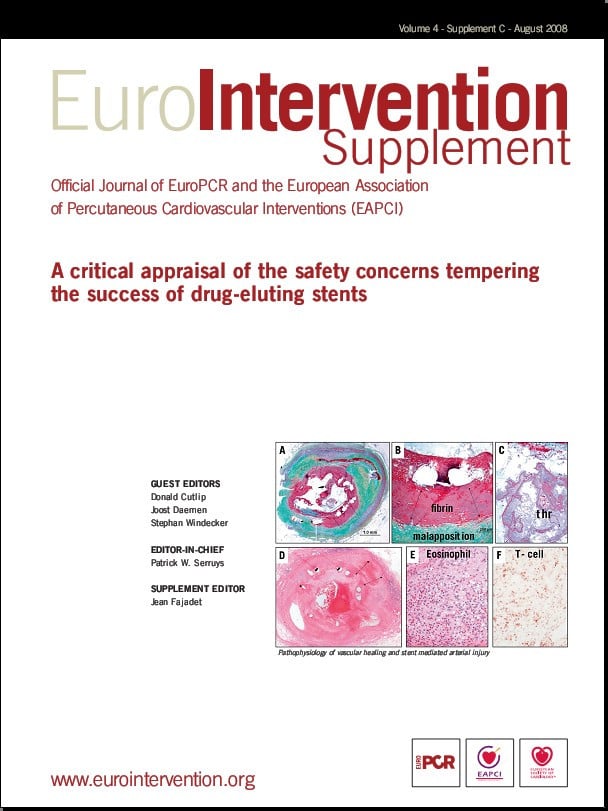Abstract from the Bern-Rotterdam registry
Abstract
Background: Stent thrombosis is a safety concern associated with use of drug-eluting stents. Little is known about occurrence of stent thrombosis more than 1 year after implantation of such stents.
Methods: Between April, 2002, and Dec, 2005, 8146 patients underwent percutaneous coronary intervention with sirolimus-eluting stents (SES; n=3823) or paclitaxel-eluting stents (PES; n=4323) at two academic hospitals. We assessed data from this group to ascertain the incidence, time course, and correlates of stent thrombosis, and the differences between early (0-30 days) and late (>30 days) stent thrombosis and between SES and PES.
Findings: Angiographically documented stent thrombosis occurred in 152 patients (incidence density 1.3 per 100 person-years; cumulative incidence at 3 years 2.9%). Early stent thrombosis was noted in 91 (60%) patients, and late stent thrombosis in 61 (40%) patients. Late stent thrombosis occurred steadily at a constant rate of 0.6% per year up to 3 years after stent implantation. Incidence of early stent thrombosis was similar for SES (1.1%) and PES (1.3%), but late stent thrombosis was more frequent with PES (1.8%) than with SES (1.4%; p=0.031). At the time of stent thrombosis, dual antiplatelet therapy was being taken by 87% (early) and 23% (late) of patients (p<0.0001). Independent predictors of overall stent thrombosis were acute coronary syndrome at presentation (hazard ratio 2.28, 95% CI 1.29-4.03) and diabetes (2.03, 1.07-3.83). Interpretation: Late stent thrombosis was encountered steadily with no evidence of diminution up to 3 years of follow-up. Early and late stent thrombosis were observed with SES and with PES. Acute coronary syndrome at presentation and diabetes were independent predictors of stent thrombosis.
(The Lancet 2007 Feb 24;369(9562):667-78) © 2008 by The Lancet.
Acknowledgement
Reprinted from The Lancet Volume 369, Issue 9562, 24 February 2007-2 March 2007, Page 667 with permission from Elsevier.
Commentary on the Bern-Rotterdam registry
The introduction of drug eluting stents (DES) was based on DES versus bare metal stent randomised clinical trials with angiographic endpoints1,2. Unfortunately, the studies were underpowered to detect infrequently occurring – but potentially severe – clinical problems such as stent thrombosis (ST). Therefore, the safety issue following the use of DES had to be remedied by different registery studies and by meta-analyses of existing randomised clinical trials. By such “surrogate trials” the interventional community made intensive efforts to describe the long-term effects of DES treatment, by putting together different pieces of information to describe a basically unknown reality.
The Bern-Rotterdam study on early and late stent thrombosis following sirolimus-eluting (SES) and paclitaxel-eluting (PES) stents is a registry adding valuable information to the DES safety puzzle. In the Bern-Rotterdam study, data from two high volume tertiary centres with an early and extensive use of DES were pooled, and the patients followed for up to three years with respect to angiographically documented ST, myocardial infarction and death. The authors found: 1) Early ST (0-30 days) accounted for 60% of the problem. Thereafter, the ST incidence increased linearly by 0.6% per year. 2) Predictors of stent thrombosis were acute coronary syndrome, diabetes, stent length and number implanted DES. 3) The rate of late stent thrombosis was higher in PES than in SES patients. The authors should be congratulated for their early and dedicated use of DES, for prospective documentation of baseline characteristics and for an extensive follow-up.
The results concerning rates of ST and the predictors of ST seem in line with later registry data and with a large head-to-head clinical comparison of SES versus PES3,4. The important finding of a linearly growing rate of ST with 0.6% per year after the first 30 days has been a major concern for high users of DES. However, such a linear growth is an unusual phenomenon in biology and will probably not continue, as can be seen in a later publication on the research registry, on Rotterdam patients treated with cypher stents5. Here, the rate of very-late ST was found to be 0.1% from year three to year four.
The finding of increased rate of late ST in PES as compared to SES has also been described in the collaborative network meta-analysis6 and in recent data from the West Denmark Heart Registry7. This finding needs further documentation, although it makes sense that results in different DES will differ on a long-term basis, and that the effect of DES treatment should not be considered a class effect.

